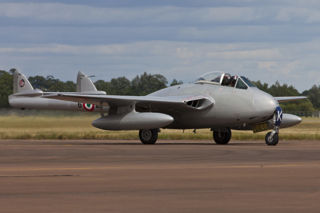
De Havilland Vampire FB.52
Developed by de Havilland and first flying in 1943, the Vampire was the second jet fighter to be operated by the RAF. Prominently made of wood, the twin-boom design proved to be highly effective with good acceleration and high manoeuvrability whilst being relatively low cost. The Vampire entered service in 1946 with RAF as an interceptor and was eventually retired in 1966 after also serving in the ground attack and training roles. Powered by a single Goblin turbojet engine, the Vampire became a record winner, most notably became the first jet aircraft to cross the Atlantic and, at the hands of legendary pilot Captain Eric ‘Winkle’ Brown became the first pure jet aircraft to land and take off from an aircraft carrier.
The Vampire was selected as one of the first two jet fighters to be operated by the RCAF. A total of 86 aircraft were ordered and the Vampire eventually became the first to be fielded in numbers. Entering service in 1948, the Vampire served with distinction until 1956 when it was replaced by the Canadair Sabre. During this time the Vampire was also flown by the RCAF Blue Devils display team.
The Norwegian Air Force Historical Squadron will be providing their airworthy Vampire FB.52 for static display at this year’s Air Tattoo. Usually displayed in the markings of the Royal Norwegian Air Force, the aircraft will be appearing this year in the markings of the Royal Canadian Air Force and will forming part of our special static display celebrating their centenary.
Photo Credit: Duncan Chase
On display
| Role | Friday | Saturday | Sunday |
|---|---|---|---|
| Static | Yes | Yes | Yes |